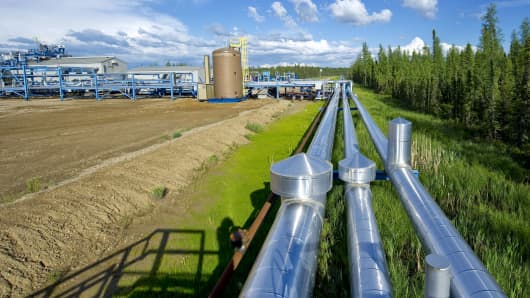
The markets started positive, but as oil dropped below $40, the markets again fell apart. Can oil companies — specifically exploration & production (E&P) companies — survive if oil remains at $40?
We’ll get a better idea in the next couple days. Nearly two dozen E&P companies will be reporting Wednesday and Thursday, including Devon Energy on Tuesday.
First off, let’s give up on trying to figure out where oil is going to be six months from now. No one can even get it right 30 days from now. There are a small group that have claimed that February was the bottom in oil, including Halliburton and Schlumberger. Maybe.
Let’s assume oil is at $40 in the fourth quarter. Oil companies can avail themselves of four courses of action:
- Never-ending cost-cutting. This has become a religion. Take ConocoPhillips, the largest E&P out there. They just posted a big loss of $985 million because massive cost-cutting could not overcome the drop in oil prices. What to do? Keep cost-cutting. They again cut their capital spending guidance to $5.5 billion from $5.7 billion previously.
Mark Hanson, Energy Analyst for Morningstar, told me this morning that cost-cutting has taken two forms: “permanent” and “cyclical.” “Permanent” cuts involve how they drill and frack wells — this is good news, because the technology has dramatically improved and they can drill cheaper.
– The “permanent” cuts are going to stick. Hanson believes we are probably in the 7th inning of “permanent” cost-cutting measures.
– “Cyclical” cuts are being driven by capacity for drilling rigs and fracking crews. These cuts may not stick because once rig activity goes up, services firms will be able to charger more. - Sell assets. Most firms are trying to meet the gap between cash flow and spending by selling assets. Seventy-five percent of the E&P universe are outspending their cash flow, relying on selling assets and debt to finance the gaps, Hanson tells me.
– Bottom line: There will be more asset sales to come. - Sell more shares. This was a common response with oil plunging below $30 in February. Marathon Oil, Newfield Exploration, Cabot Oil & Gas and Pioneer Natural Resources all priced secondaries earlier this year. Devon Energy, for example, priced a 69-million share secondary at $18.75 in mid-February. This was a small discount to the prior day’s price, and though the deal increased Devon’s float by roughly 15 percent, it was snapped up eagerly by investors (the initial deal size was 55 million and increased to 69 million on strong demand.
– Still, selling shares is a fairly drastic alternative. Most of the larger companies — Anadarko Petroleum, Devon, Apache — have repaired their balances sheets by cost-cutting and asset sales and seem to be in pretty good shape.
– And it raises a more delicate question: Would the investor appetite to buy still be there? - Mergers. The most drastic step but increasingly likely. While the bigger names like Apache or EOG or Anadarko may not feel the need to merge, there are dozens of small- and mid-size companies — Concho Resources, Cimarex Energy, Pioneer Natural Resources, and Whiting Petroleum among many others — that might.
– And don’t think the U.S. government’s take-down of the Baker-Hughes-Halliburton merger kills M&A in this space. In that case, there was a concern that Baker-Hughes-Halliburton would corner too much of the oil services market. There is no danger of any one company obtaining a near-monopoly in the E&P space. - [“source -pcworld”]



